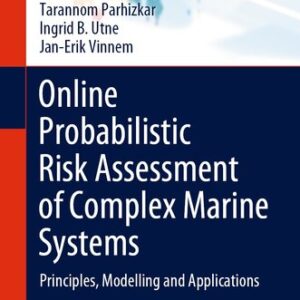| Title: | Technology and Safety of Marine Systems | Volume: | |||||||||||||||||||
| Author(s): | Anand Pillay and Jin Wang (Eds.) | ||||||||||||||||||||
| Series: | Elsevier Ocean Engineering Series 7 | Periodical: | |||||||||||||||||||
| Publisher: | Elsevier Science | City: | |||||||||||||||||||
| Year: | 2003 | Edition: | 1 | ||||||||||||||||||
| Language: | English | Pages (biblio\tech): | 1-320\335 | ||||||||||||||||||
| ISBN: | 0080441483, 9780080441481, 9780080542249 | ID: | 631029 | ||||||||||||||||||
| Time added: | 2011-08-31 04:54:40 | Time modified: | 2022-10-19 04:39:25 | ||||||||||||||||||
| Library: | Library issue: | до 2011-08 | |||||||||||||||||||
| Size: | 14 MB (14860497 bytes) | Extension: | |||||||||||||||||||
| Worse versions: | BibTeX | Link | |||||||||||||||||||
| Desr. old vers.: | 2013-11-03 09:07:56; 2016-04-03 09:51:08; 2016-11-04 05:36:18; | Edit record: | Libgen Librarian | ||||||||||||||||||
| Commentary: | |||||||||||||||||||||
| Topic: | Technique\\Transportation: Ships | Tags: | Транспорт;Судостроение | ||||||||||||||||||
| Identifiers: |
|
||||||||||||||||||||
| Book attributes: |
|
||||||||||||||||||||
| Mirrors: |
|
||||||||||||||||||||
| Traditionally society has regulated hazardous industries by detailed references to engineering codes, standards and hardware requirements. These days a risk-based approach is adopted. Risk analysis involves identifying hazards, categorizing the risks, and providing the necessary decision support to determine the necessary arrangements and measures to reach a “safe” yet economical operating level. When adopting such an approach the abundance of techniques available to express risk levels can often prove confusing and inadequate. This highly practical guide to safety and risk analysis in Marine Systems not only adds to the current techniques available, but more importantly identifies instances where traditional techniques fall short. Uncertainties that manifest within risk analysis are highlighted and alternative solutions presented. In addition to risk analysis techniques this book addresses influencing elements including: reliability, Maintenance Decision making and Human error. The highly practical approach of this title ensures it is accessible to the widest possible audience | |||||||||||||||||||||
|
Table of contents : Preface Chapter 1 Introduction Original Research Article Chapter 2 Ship safety and accident statistics Original Research Article Chapter 3 Safety analysis techniques Original Research Article Chapter 4 Formal safety assessment of ships and its relation to offshore safety case approach Original Research Article Chapter 5 Formal safety assessment Original Research Article Chapter 6 Risk assessment using fuzzy set approach Original Research Article Chapter 7 Modified failure mode and effects analysis Original Research Article Chapter 8 Maintenance modelling Original Research Article Chapter 9 Human error assessment and decision making using analytical hierarchy processing Original Research Article Chapter 10 Three novel risk modelling and decision making techniques Original Research Article Chapter 11 Conclusions Original Research Article Appendix 1 Code of practice for the safety of small fishing vessels Appendix 2 Fishing vessel (safety provisions) safety rules 1975 Appendix 3 Influence diagram Subject index |
|||||||||||||||||||||
Technology and Safety of Marine Systems
920,00 EGP
+ Free ShippingTraditionally society has regulated hazardous industries by detailed references to engineering codes, standards and hardware requirements. These days a risk-based approach is adopted. Risk analysis involves identifying hazards, categorizing the risks, and providing the necessary decision support to determine the necessary arrangements and measures to reach a “safe” yet economical operating level. When adopting such an approach the abundance of techniques available to express risk levels can often prove confusing and inadequate. This highly practical guide to safety and risk analysis in Marine Systems not only adds to the current techniques available, but more importantly identifies instances where traditional techniques fall short. Uncertainties that manifest within risk analysis are highlighted and alternative solutions presented. In addition to risk analysis techniques this book addresses influencing elements including: reliability, Maintenance Decision making and Human error. The highly practical approach of this title ensures it is accessible to the widest possible audience






المراجعات
لا توجد مراجعات بعد.